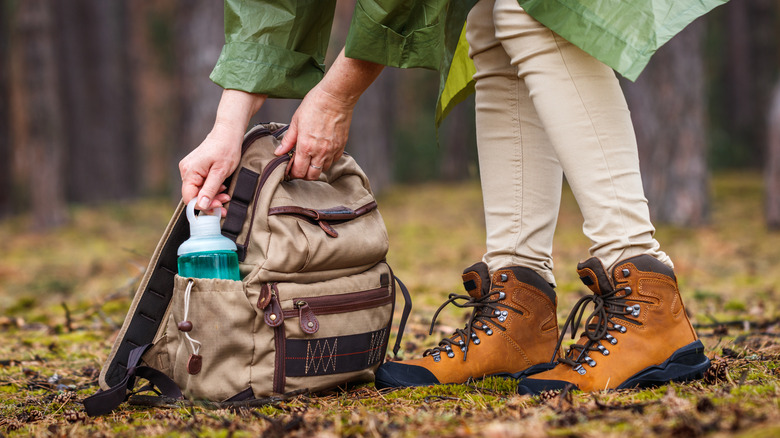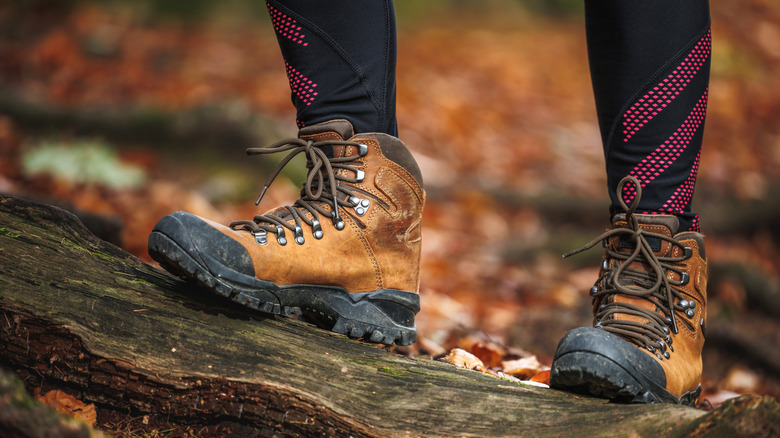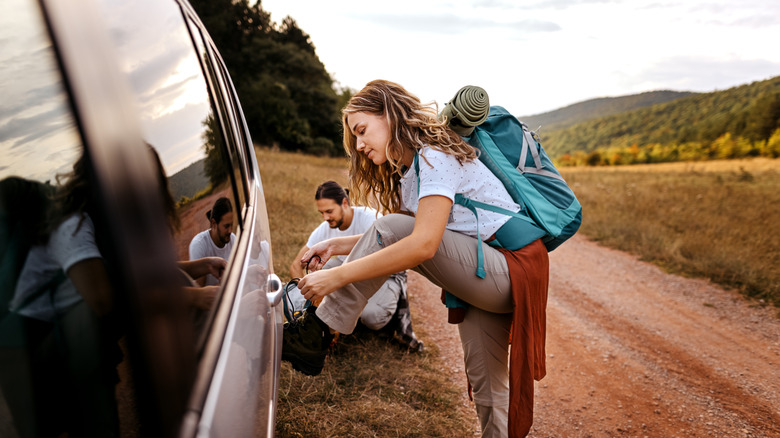One Essential Camping Item Works Wonders For Waterproofing Shoes And Hiking Boots
We may receive a commission on purchases made from links.
Keeping your feet dry could be the difference between having an amazing camping trip or a miserable one, especially when you're in the woods with rain clouds overhead and muddy trails underfoot. To prepare for wet camping weather, you might consider packing an extra pair of waterproof boots, but that's probably overkill. So, instead of that, you could just make use of one natural item to save the day: beeswax — a substance that can shield your regular shoes from water. But how does this work? When you apply beeswax on materials such as leather or canvas, it creates a thin, hydrophobic layer that prevents water from soaking in.
Beeswax is an old-school trick that can be really handy for modern campers, as it's a great way to prepare for unexpected bad weather conditions. All you need is to heat it, rub it across your shoes, heat it again to help it set, and voilà — waterproofing achieved. While the use of beeswax might not exactly replace technical waterproof gear, it can sure keep those toes dry in an unexpected downpour or when crossing a shallow creek. Beeswax is easy to pack as it hardly takes up any space. You could simply tuck a small block in your camping kit, day pack, or glove compartment.
Waterproofing your hiking boots with beeswax
Researching the best hiking boots is not enough for a successful outdoor trip. Being a step ahead of watery situations by packing some emergency beeswax is equally useful — and it's easier than you might think. Cleaning your shoes or hiking boots is the first step, as this is important to get rid of dirt that could prevent the beeswax from adhering to the fabric. Melt the beeswax over the fire or your camping stove and rub it all over the surface of the shoes. You can rub with a cloth or towel — although you may also apply the beeswax straight from the block. After coating the boots, apply mild heat to melt the wax into the material. You can do this by holding the boots close to a campfire (but be careful not to keep it too close).
The best materials to use beeswax on are leather and canvas, as the beeswax bonds well to these kinds of fabric. Note, however, that light-colored shoes tend to get darkened after application. But isn't that a fair trade for dry feet? You should be cautious when it comes to high-tech synthetic materials or suede because beeswax can cause texture changes and other damage due to their sensitivity. If your boots come with waterproofing or Gore-Tex lining, it's best to stick with manufacturer recommendations. To be sure that your waterproofing has worked, just splash some water on the treated surface. If the water beads and rolls away, then you're good to go. But if it doesn't, you may have to repeat the process and add a second layer.
Staying dry while camping or hiking
For anyone who's conscious about their budget when camping, the good news is that beeswax is widely available and affordable. A tin or block of natural beeswax could cost anything between $5 and $10, which can be enough for several pairs of boots. Getting it is easy from online retailers like this Skidmore's Premium Beeswax for Waterproofing on Amazon, at local camping gear stores, or shops that sell natural products. Some brands even have beeswax that are blended with oils like almond or jojoba, which enables easier spreading, and gives more shine.
Regarding how to store your beeswax, make sure to keep it somewhere that's cool and dry, such as a resealable pouch or a small tin. The good thing is that beeswax is shelf-stable and easy to store, unlike spray waterproofers that tend to leak or lose pressure. This makes beeswax ideal for backcountry trips where supplies are typically limited. Just remember to avoid overusing it, or you might end up with an overly sticky pair of boots attracting dust and dirt along the way. How often you have to reapply beeswax depends on how frequently you go hiking. While a once-per-season use may suffice for weekend warriors, reapplying every few weeks may be necessary for those who face wet conditions regularly. It's generally helpful to check if water still beads on your boots, especially after a rainy day. In case it doesn't, then a fresh coat is needed. Here's the best way to waterproof your backpacking for hiking.


